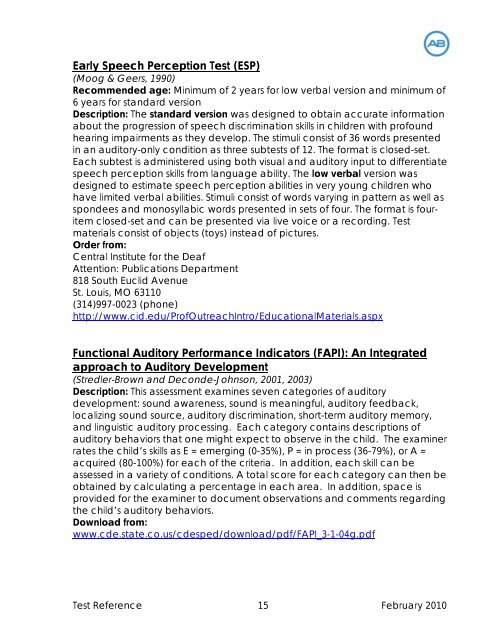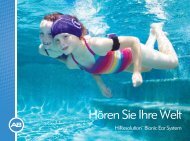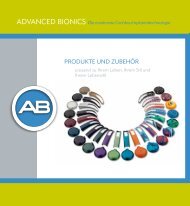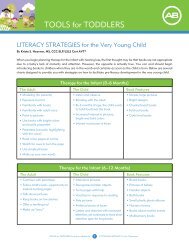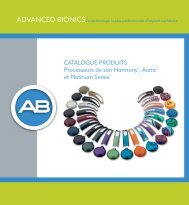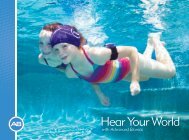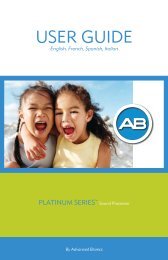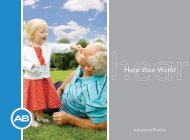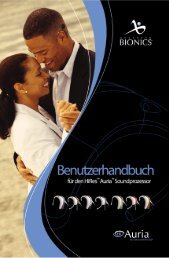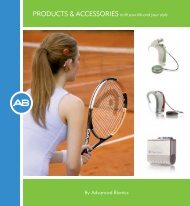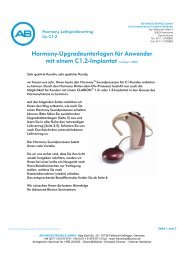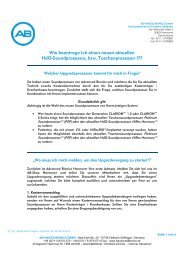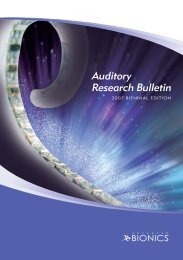Test Reference for Cochlear Implants - The ... - Advanced Bionics
Test Reference for Cochlear Implants - The ... - Advanced Bionics
Test Reference for Cochlear Implants - The ... - Advanced Bionics
You also want an ePaper? Increase the reach of your titles
YUMPU automatically turns print PDFs into web optimized ePapers that Google loves.
Early Speech Perception <strong>Test</strong> (ESP)<br />
(Moog & Geers, 1990)<br />
Recommended age: Minimum of 2 years <strong>for</strong> low verbal version and minimum of<br />
6 years <strong>for</strong> standard version<br />
Description: <strong>The</strong> standard version was designed to obtain accurate in<strong>for</strong>mation<br />
about the progression of speech discrimination skills in children with profound<br />
hearing impairments as they develop. <strong>The</strong> stimuli consist of 36 words presented<br />
in an auditory-only condition as three subtests of 12. <strong>The</strong> <strong>for</strong>mat is closed-set.<br />
Each subtest is administered using both visual and auditory input to differentiate<br />
speech perception skills from language ability. <strong>The</strong> low verbal version was<br />
designed to estimate speech perception abilities in very young children who<br />
have limited verbal abilities. Stimuli consist of words varying in pattern as well as<br />
spondees and monosyllabic words presented in sets of four. <strong>The</strong> <strong>for</strong>mat is fouritem<br />
closed-set and can be presented via live voice or a recording. <strong>Test</strong><br />
materials consist of objects (toys) instead of pictures.<br />
Order from:<br />
Central Institute <strong>for</strong> the Deaf<br />
Attention: Publications Department<br />
818 South Euclid Avenue<br />
St. Louis, MO 63110<br />
(314)997-0023 (phone)<br />
http://www.cid.edu/ProfOutreachIntro/EducationalMaterials.aspx<br />
Functional Auditory Per<strong>for</strong>mance Indicators (FAPI): An Integrated<br />
approach to Auditory Development<br />
(Stredler-Brown and Deconde-Johnson, 2001, 2003)<br />
Description: This assessment examines seven categories of auditory<br />
development: sound awareness, sound is meaningful, auditory feedback,<br />
localizing sound source, auditory discrimination, short-term auditory memory,<br />
and linguistic auditory processing. Each category contains descriptions of<br />
auditory behaviors that one might expect to observe in the child. <strong>The</strong> examiner<br />
rates the child’s skills as E = emerging (0-35%), P = in process (36-79%), or A =<br />
acquired (80-100%) <strong>for</strong> each of the criteria. In addition, each skill can be<br />
assessed in a variety of conditions. A total score <strong>for</strong> each category can then be<br />
obtained by calculating a percentage in each area. In addition, space is<br />
provided <strong>for</strong> the examiner to document observations and comments regarding<br />
the child’s auditory behaviors.<br />
Download from:<br />
www.cde.state.co.us/cdesped/download/pdf/FAPI_3-1-04g.pdf<br />
<strong>Test</strong> <strong>Reference</strong> 15 February 2010


